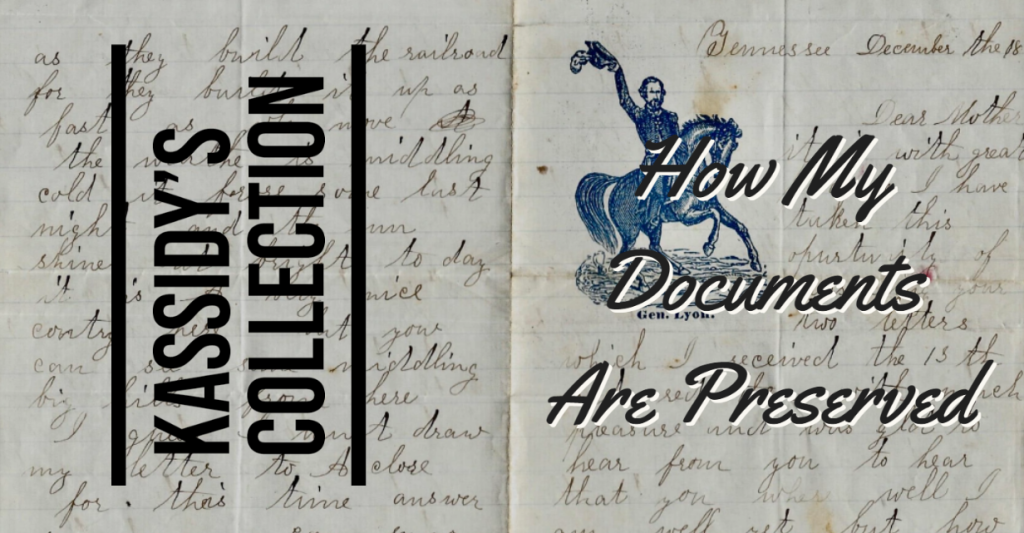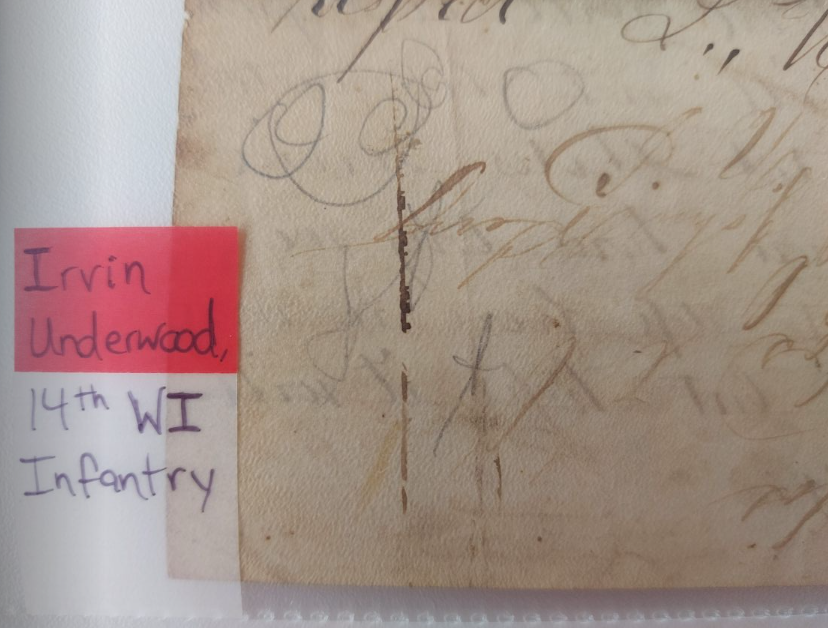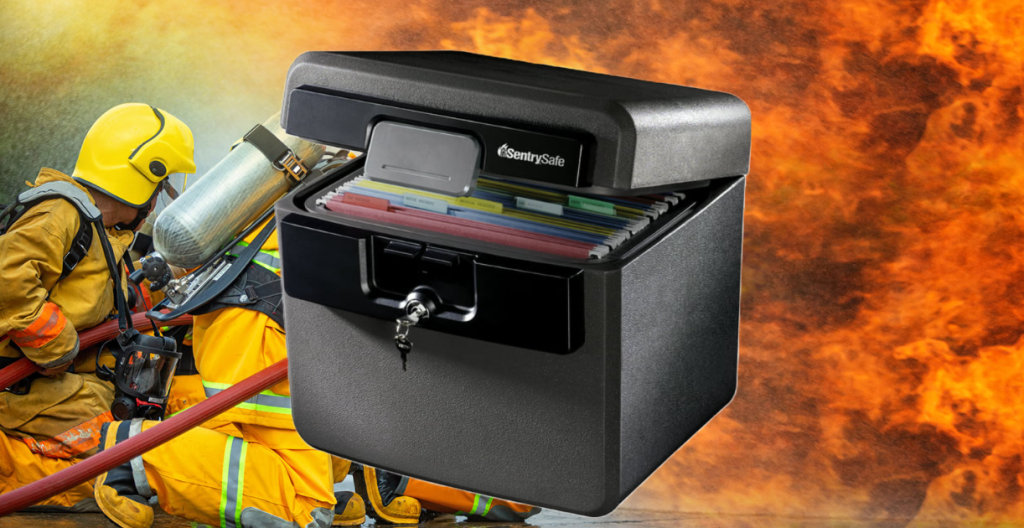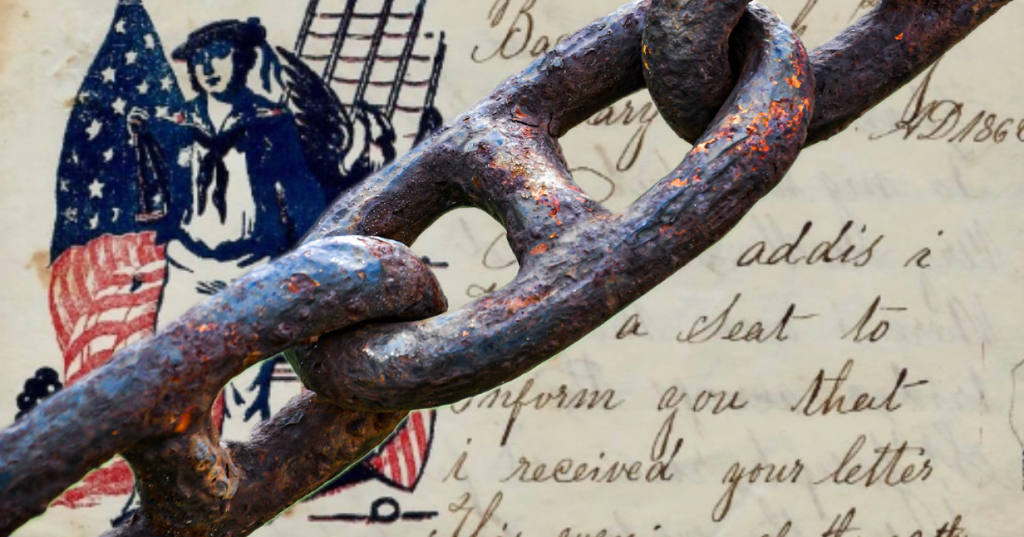

In my last post, I shared details on how to properly preserve primary sources, including letters. This month, I’m giving you a behind-the-scenes peek at how my documents are preserved, while also offering some organizational tips. So grab your binder, archival sleeves, and historic letters, because it’s time to dive right in!


Binder – If you grabbed the supplies I mentioned in last month’s post, you’ll already have a 3-ring binder on hand. And the good news is–there’s a super simple way to enhance this binder’s overall look and functionality. If you’ll have multiple binders in your collection, you can easily keep up with which one is which by utilizing the sleeve on the binder’s front. Using standard white paper and just a bit of ink, you can label the binder based on the contents therein.
Since the documents I have in my collection are sort of eclectic–from family heirlooms and Civil War letters to World War II papers and historic newspapers–I opted to label mine in a general way: “Historical Letters & Documents” (see above). Of course, if you have specific documents in a folder (like letters from John Smith), you could always label the binder “John Smith Letters.”
If you were able to snag one of the binders I shared last month, you’ll also notice that the spine provides a labeling space, too. For my binder, I decided to keep it similar to how I had the front labeled (see below). The beauty of labeling the spine of your binder is that it’s easily spotted no matter where it’s stored–even if you have it on a shelf.

Finally, you’ll notice that the binder has a space on the back to slip in a piece of paper. While there are plenty of different routes you could go, I chose to include an index (see below). That way, when I’m looking for a specific document, I’ll have a general idea of where it’s stored in my binder. Since I do have some letters written by the same person, I chose to go more specific with my index. For example, instead of writing “Jerome Sears Letter,” I decided to include the date: “Jerome Sears Letter (Aug. 18, 1863).” Overall, how you label your binder is completely up to you–you get to decide what works (or what doesn’t!) for your personal collection.



Organization – When you consider how you want to organize your primary sources, there are multiple options available. And to be honest, as long your artifacts are properly preserved, there’s not a single organizational method that’s entirely “wrong.” That said, here are my organizational tips, depending on what sort of documents you have in your collection:
Letters by the Same Author: If you have letters written from one just one person–like John Smith, let’s say–then I suggest arranging your documents chronologically. In other words, if John Smith wrote one letter in December 1778 and another in February 1782, the document from December 1778 should appear in your binder first. When you consider chronological arrangements, be sure to look at the year a letter was written, not just the month or day.
Letters Written by Multiple People: If you’re like me and have letters written by multiple people–and some of these people wrote more than one letter in your archive–organization can get a bit more tricky. Since there isn’t normally a super clear way to organize letters of this nature, I opt to arrange them by how they were received. For example, Sewall Adams (127th NY Infantry) penned my first Civil War soldier letter, so his writings appear first in my collection. On the other hand, Samuel Marshal (21st OH Infantry) was one of the last I received, so his appears last in my collection of Civil War correspondences. All the letters I received after Sewall Adams, but before Samuel Marshal, appear in the middle of my collection.
Of course, for some soldiers, I have more than one letter in my archive that they penned. In that instance, I’ll add some chronological arrangement elements. Since I have two letters penned by Sewall Adams in the same year (1863), I’ll organize the documents by month–February 1863 comes before June 1863. As a recent example, a couple of years ago I procured a letter written by William George Strausbaugh (101st OH Infantry) in June 1863. Just recently, I added another letter of his to my collection, penned in December 1862. Even though William George Strausbaugh’s June letter was in my collection first, I organized it after his December letter, since December 1862 precedes June 1863.
Disjointed Letters: When writing to loved ones, individuals sometimes used more than one sheet of paper. And when I add a letter to my collection like this, I have a special organization method. Because I like to have my letters folded out for preservation purposes–and I refrain from touching the letters to further preserve them–I had to get a bit creative when Charles “Charley” Henry Howe’s (36th MA Infantry) letter arrived a few years back. Written on two separate sheets of paper and with an envelope still intact, I decided to use two archival sleeves for storage. This way, I can easily view all of his thoughts without handling the fragile papers.
Even so, I was afraid that some day a collector may not be aware that the two parts of this letter go together. So I decided to use some Post-It Tabs for labeling purposes (see below). For this particular letter, I labeled a part one and part two, as follows: “Charles Henry Howe, 36th MA Infantry (Part 1) 5-1-1863” and “Charles Henry Howe, 36 MA Infantry (Part 2) 5-1-1863.” Notice that I included the soldier’s name, regiment, the letter’s date, and the different parts. This way, hopefully someone will one day recognize that these letters–while disjointed for preservation purposes–do go together.

Miscellaneous Documents: If your collection is anything like mine, you may have a hodge-podge of primary sources within one binder. When you have a slew of documents to organize, there’s a lot of different directions you could go. Here’s how mine are organized:
- Family Documents – Family documents are first up in my binder for a few different reasons. One is that I have fewer family documents in my binder than other sources, so I like having them organized first. Second is that these documents, with a family connection, are extra special to me, so I enjoy having them easily accessible.
- Civil War Letters – Why do Civil War letters come next? Because they’re the bulk of my primary source collection, with 20 (and counting!) currently in my archives.
- Civil War Documents – I try to keep similar items together, so I decided to organize Civil War-related documents after my letters. These items are everything from a Civil War envelope and discharge certificate to 1922 GAR program and Battle of Shiloh reunion invitation. Even if the item is post-Civil War, I’ll still include it in this area if it has Civil War ties.
- Newspapers – I also have some historical newspapers in my collection, so those come next! I normally opt for chronological arrangement here, so my 1683 newspaper precedes my 1778 and 1820 newspaper.
- Postcards – I have a few post cards in my collection, so I include those next. You could opt for chronological arrangement or arrange them in how they were obtained.
- Miscellaneous – Remember how I said my archive is a hodge-podge? Well, some of my primary sources are completely unrelated to the other documents in my archive, so I normally arrange them toward the end of my binder. Some miscellaneous items I’ll place toward the end of my collection include a World War II letter, 1901 check, and so forth.


Post-It Tabs – I talked before about using Post-It Tabs on Charley Henry Howe’s disjointed letter. But I also like to use these tabs for all my documents, because it aids preservation. One day, someone may not know what regiment these soldiers served with. While they could always do their own research (and I sincerely hope they do!), I make it easy by using Post-It Tabs to set these future genealogists and historians on the right path. On these tabs, I write the soldier’s name and regiment, like so: “Jerome Sears, 93rd NY Infantry.” When I acquired a small archive belonging to Civil War soldier Lewis J. Dale (23rd MO Infantry), I used these tabs to denote what documents came from his archive. For example: “1922 GAR Program. From Lewis J. Dale (23rd MO Infantry) Archive.”
I suggest using a fine tip black Sharpie to write on these Post-It Tabs, as the ink should hold up better, resist smudging, and be clearly visible. Of course, you’ll stick these tabs on the archival sleeve, not on the document itself. I also suggest writing on the tab and letting is dry before applying it to archival sleeve, just in case your hand happened to slip and Sharpie ink transferred to the protective sleeve. A great thing about these tabs, though, is that they hold their stickiness well (I’ve had some on my archival sleeves for a few years by now) but are still movable if you ever need to remove these tabs. I suggest snagging these Post-It Tabs for under $5!


Safe – I know I discussed this in my last post, but I’ve got to make a quick mention of it here, too, because I believe it’s an important preservation tool. Here it comes–you 100% should store your primary sources in a fire and waterproof safe. If you’ve followed all of my tips, but fail to store your documents in a safe, then you’re only one disaster away from having these priceless papers ruined. While safes are pricier than my other preservation methods–and admittedly harder to store–they offer a peace of mind that you just can’t put a price tag on. Plus, the SentrySafe HD4100 (which I recommend) is just under $70. Mine holds two 3-ring binders and a couple of smaller books, so there’s quite a bit of room.


Collecting primary sources is sort of like a chain that connects us all–the original letter writer and those who have carefully preserved the documents over the following decades. When you became the caretaker of primary documents, either through purchasing them or inheriting them, you become a link in that chain, passing down these artifacts for others to one day enjoy, too. While I know it can be a lot of pressure to find ways to properly preserve one-of-a-kind or rare primary sources like letters and newspapers, I believe you’re up to the task and will succeed in saving these primary sources for the future. And luckily, if you’ve followed my suggestions, you’re on a great path both preservation AND organization-wise!
Keep Sharing the History!



